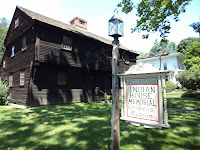The central Connecticut River Valley has been a homeland for Native peoples of at least 10,000 years. Over time, Native people adapted their lifeways to new plants, animals and changing environments. They knew precisely which seasonal resources to use for food, shelter, and medicine. The forests were a managed wilderness; planting lands were cleared and cultivated, and forest underbrush was periodically burned to encourage the growth of useful plants to generate new growth to feed deer herds, and to ease travel.

 Local resources included a wide variety of foods and medicines from animals, fish, birds, berries, roots, barks, leaves, and saps. About 3,000 years ago, Native people here began to cultivate seeds ad roots from plants like sunflower and goosefoot. About 800 years ago, they began growing and storing large quantities of corn. Common food mixtures included pemmican, dried meat and berries; yokeag, ground parched corn mixed with maple sugar; and succotash, a stew of corn and beans.
Local resources included a wide variety of foods and medicines from animals, fish, birds, berries, roots, barks, leaves, and saps. About 3,000 years ago, Native people here began to cultivate seeds ad roots from plants like sunflower and goosefoot. About 800 years ago, they began growing and storing large quantities of corn. Common food mixtures included pemmican, dried meat and berries; yokeag, ground parched corn mixed with maple sugar; and succotash, a stew of corn and beans.Pocumtuck people lived in a large homeland that included seasonal hunting territories, fishing areas, gathering places, ad sacred sites. Native homes, known as wigwams, were covered with woven mats or bark that could be easily moved to different locations. Temporary fishing and traveling camps where built alongside the river, and more permanent homesites and food storage places were on elevated lands above the floodplains. Networks of trails ad waterways connected different extended kin groups and nations.
Vocabularyadapt = ปรับตัว
precisely = อย่างแม่นยำ
shelter = ที่อยู่อาศัย
cultivate = เพาะปลูก
periodically = อย่างเป็นช่วงๆ
generate = ผลิต
native people = ชนพื้นเมือง
territory = ดินแดน
sacred site = สถานที่ศักดิ์สิทธิ์
kin = ญาติ